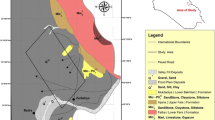Abstract
A series of 2D apparent resistivity data were generated over two synthetic models representing different geological or environmental conditions commonly associated with geophysical applications for hydrogeological, environmental and engineering investigations. The apparent resistivity data were generated for the following arrays: Wenner-alpha (WA), Wenner-beta (WB), Wenner–Schlumberger (WSC), dipole–dipole (DDP), pole–dipole (PDP) and pole–pole (PP) arrays, which were paired such that apparent resistivity data for 2D profiles in a parallel direction are obtained with a particular array type and those in a perpendicular direction are observed with a different array type. The 2D apparent resistivity data for the orthogonal paired-arrays were then collated to 3D data sets. The effectiveness and efficiency of the orthogonal paired-arrays in 3D geoelectrical resistivity imaging were evaluated by determining the mean absolute anomaly effects of the electrode configurations on the synthetic models. The results show that DDP–PDP, DDP–PP, DDP–WSC, PDP–PP, DDP–WB, PDP–WB and WB–WSC orthogonal paired-arrays produced higher anomaly effects on the synthetic models. This indicates that DDP–PDP, DDP–PP, DDP–WSC, PDP–PP, DDP–WB, PDP–WB and WB–WSC orthogonal paired-arrays are more sensitive to 3D features of the geologic models than the other orthogonal paired-arrays investigated.






Similar content being viewed by others
References
Aizebeokhai AP, Olayinka AI, Singh VS (2009) Numerical evaluation of 3D geoelectrical resistivity imaging for environmental and engineering investigations using orthogonal 2D profiles. SEG Expanded Abstracts 28:1440–1444. doi:10.1190/1.3255120
Aizebeokhai AP, Olayinka AI, Singh VS (2010) Application of 2D and 3D geoelectrical resistivity imaging for engineering site investigation in a crystalline basement terrain, southwestern Nigeria. J Environ Earth Sci. doi:10.1007/s12665-010-0474-z
Amidu SA, Olayinka AI (2006) Environmental assessment of sewage disposal systems using 2D electrical resistivity imaging and geochemical analysis: a case study from Ibadan, Southwestern Nigeria. Environ Eng Geosci 7(3):261–272
Bentley LR, Gharibi M (2004) Two- and three-dimensional electrical resistivity imaging at a heterogeneous site. Geophysics 69(3):674–680
Carruthers RM, Smith IF (1992) Hydrogeology of crystalline basement aquifers in Africa. In: Wright EP, Burgess WG (eds) The use of ground electrical survey methods for sitting water supply boreholes in shallow crystalline basement terrain. Geological Society Special Publication 66, pp 203–220
Chambers JE, Ogilvy RD, Meldrum PI, Nissen J (1999) 3D electrical resistivity imaging of buried oil-tar contaminated waste deposits. Eur J Environ Eng Geophys 4:3–15
Chambers JE, Ogilvy RD, Kuras O, Cripps JC, Meldrum PI (2002) 3D electrical mapping of known targets at controlled environmental test site. Environ Geol 41:690–704
Dahlin T, Loke MH (1998) Resolution of 2D Wenner resistivity imaging as assessed by numerical modelling. J Appl Geophys 38(4):237–248
Dahlin T, Zhou B (2004) A numerical comparison of 2D resistivity imaging with 10 electrodes array. Geophys Prospect 52:379–398
Dey A, Morrison HF (1979) Resistivity modelling for arbitrary shaped two-dimensional structures. Geophys Prospect 27:1020–1036
Griffiths DH, Barker RD (1993) Two dimensional resistivity imaging and modelling in areas of complex geology. J Appl Geophys 29:211–226
Griffiths DH, Turnbull J, Olayinka AI (1990) Two-dimensional resistivity mapping with a complex controlled array. First Break 8(4):121–129
Hazell JRT, Cratchley CR, Jones CRC (1992) The hydrology of crystalline aquifers in northern Nigeria and geophysical techniques used in their exploration. In: Wright EP, Burgess WG (eds) Hydrogeology of crystalline basement aquifers in Africa. Geological Society Special Publication 66, pp 155–182
Koefoed O (1979) Geosounding principles. 1. Resistivity sounding measurements. Elsevier, Amsterdam
Li Y, Oldenburg DW (1994) Inversion of 3D DC resistivity data using an approximate inverse mapping. Geophys J Int 116:527–537
Loke MH, Barker RD (1996) Practical techniques for 3D resistivity surveys and data inversion. Geophys Prospect 44:499–524
Militzer H, Rosler R, Losch W (1979) Theoretical and experimental investigations of cavity research with geoelectrical resistivity methods. Geophys Prospect 27:640–652
Ogilvy R, Meldrum P, Chambers J (1999) Imaging of industrial waste deposits and buried quarry geometry by 3D tomography. Eur J Environ Eng Geophys 3:103–113
Olayinka AI (1999) Advantage of two-dimensional geoelectrical imaging for groundwater prospecting: case study from Ira, southwestern Nigeria. J Natl Assoc Hydrogeol 10:55–61
Olayinka AI, Yaramanci U (1999) Choice of the best model in 2-D geoelectrical imaging: case study from a waste dump site. Eur J Environ Eng Geophys 3:221–244
Park S (1998) Fluid migration in the vadose zone from 3D inversion of resistivity monitoring data. Geophysics 63:41–51
Press WH, Teukolsky SA, Vetterling WT, Flannery BP (1996) Numerical recipes in Fortran 77: the art of scientific computing, 2nd edn. Cambridge University Press, Cambridge
Telford WM, Geldart LP, Sheriff RE, Keys DA (1976) Applied geophysics. Cambridge University Press, London, p 860
Author information
Authors and Affiliations
Corresponding author
Rights and permissions
About this article
Cite this article
Aizebeokhai, A.P., Olayinka, A.I. Anomaly effects of orthogonal paired-arrays for 3D geoelectrical resistivity imaging. Environ Earth Sci 64, 2141–2149 (2011). https://doi.org/10.1007/s12665-011-1041-9
Received:
Accepted:
Published:
Issue Date:
DOI: https://doi.org/10.1007/s12665-011-1041-9




